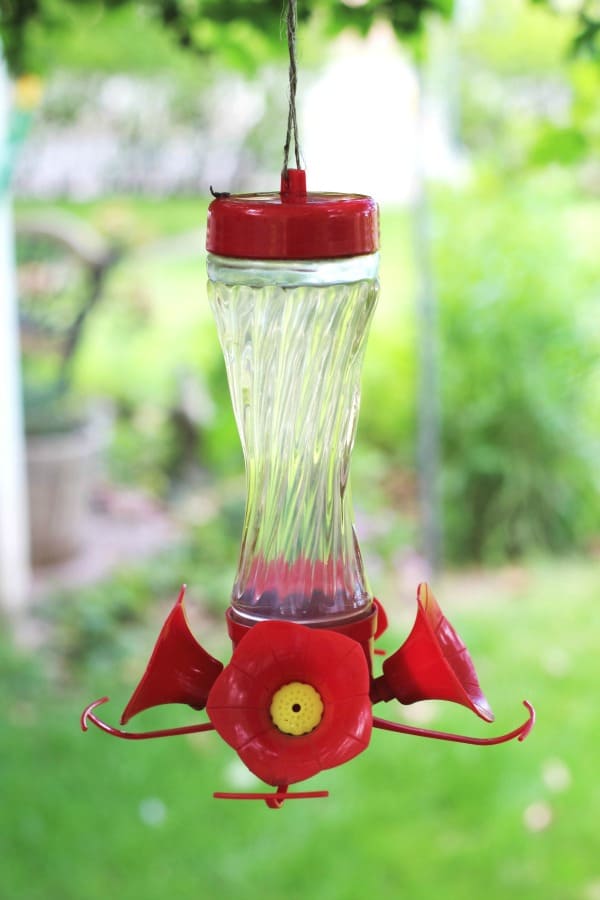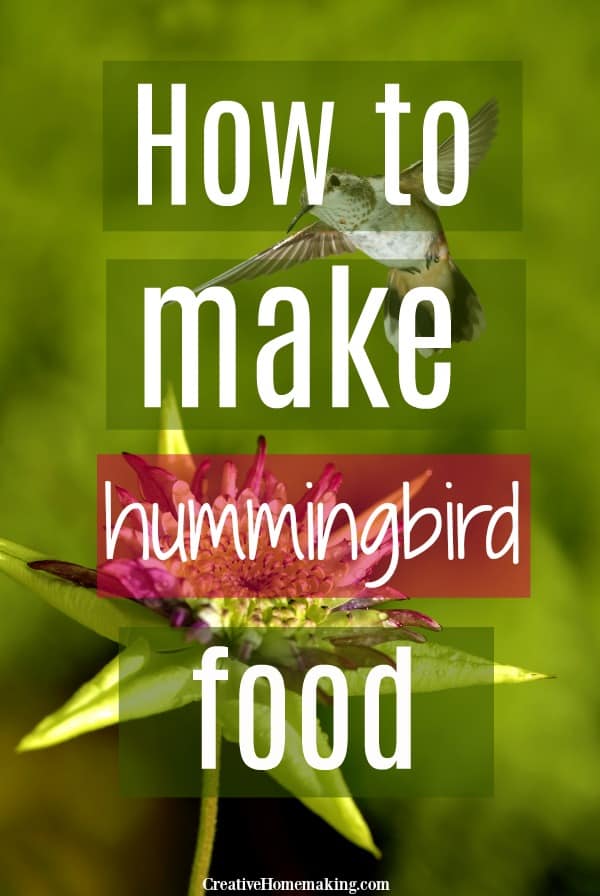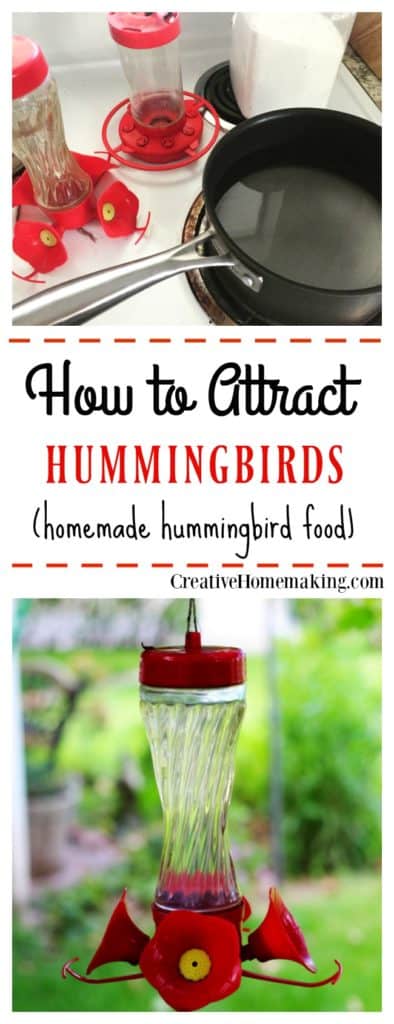Hummingbirds are fascinating creatures to watch and attract to your yard. These tiny birds are known for their ability to hover in mid-air and fly backwards, making them a joy to observe. One of the best ways to attract hummingbirds to your yard is by offering them a steady supply of nectar. In this article, I will explore how to make homemade hummingbird food, the best ingredients to use, and how to properly store and maintain your hummingbird feeders.
This post may contain affiliate links.
Hummingbirds require a diet that is high in sugar to sustain their energy levels. While they do feed on insects and spiders, nectar is their primary source of food. Making your own hummingbird food is a simple and cost-effective way to provide these birds with the nourishment they need.
Vintage Antique Glass Bottle Hummingbird Feeder, 20-Ounce Hummingbird Nectar Capacity, Burnt Penny Finish
Why Make Your Own Hummingbird Food
Making your own hummingbird food is a simple and inexpensive way to attract these beautiful birds to your yard. There are several reasons why many birders prefer to mix their own sugar solution instead of buying commercial nectar.
- Commercial nectars often contain unnecessary additives such as red dyes, flavorings, and preservatives that can be harmful to hummingbirds. By making your own nectar, you can ensure that it is pure and healthy for the birds.
- Making your own hummingbird food is more cost-effective than buying pre-made nectar. All you need is sugar and water, which are readily available and inexpensive.
- Making your own nectar allows you to control the quality of the ingredients. You can use organic sugar and filtered water to ensure that the nectar is of the highest quality.
- Making your own hummingbird food allows you to customize the nectar to suit your local hummingbird population. For example, if you notice that certain flowers in your yard are particularly popular with the hummingbirds, you can add a little bit of their nectar to the sugar solution to make it even more appealing.
Mason Jar Hummingbird Feeder
The Best Recipe for Homemade Hummingbird Food
To make the best homemade hummingbird food, all you need are two simple ingredients: refined white sugar and tap water. It is important to note that you should never use honey, brown sugar, or any other sweeteners as they can be harmful to hummingbirds. Additionally, do not add any food coloring to the mixture as it is unnecessary and potentially harmful to the birds.
Related Article: Attract Hummingbirds and Butterflies to Your Garden with These Plants
To make the hummingbird food, follow these simple steps:
- In a saucepan, bring one cup of tap water to a boil.
- Add ¼ cup of refined white sugar to the boiling water.
- Stir the mixture until the sugar dissolves completely.
- Remove the mixture from the heat and allow it to cool to room temperature.
- Fill your hummingbird feeder with the sugar water and hang it outside.

Storage and Timing
It is recommended to make only enough hummingbird food that can be used within a week. Any extra sugar water can be stored in a refrigerator for up to two weeks. When storing the mixture, ensure that the container is clean and tightly sealed. Remember to clean your hummingbird feeder every time you refill it to prevent the growth of harmful bacteria.
Related Article: Colors of Petunias: A Guide to Different Varieties
Safety Tips
To ensure the safety of hummingbirds, it is important to follow these tips:
- Use only refined white sugar and tap water.
- Do not add any food coloring to the mixture.
- Boil the tap water to remove any impurities.
- Allow the mixture to cool before filling the hummingbird feeder.
- Clean the hummingbird feeder regularly to prevent the growth of harmful bacteria.
- If you notice bees or other predators around the feeder, move it to a different location.
- Place the feeder near plants that hummingbirds are attracted to.
- Place the feeder away from windows to prevent bird collisions.
- If you notice increased hummingbird activity, it may be a sign that they are nesting nearby. Be respectful of their territorial behavior and avoid disturbing them.

Alternatives to White Sugar
When making hummingbird food, some people prefer to use alternatives to white sugar. Here are some options to consider:
Brown Sugar and Molasses
Brown sugar and molasses can be used as an alternative to white sugar in hummingbird food. Molasses gives white sugar a darker color and a slightly different taste. Molasses is also a byproduct of the sugar-making process and has a rich, sweet flavor. However, it’s important to note that brown sugar and molasses can contain trace impurities that may cause nectar to spoil more quickly.
Hummingbird Feeder Vintage Red Glass Jug, 23-Ounce Hummingbird Nectar Capacity
Corn Syrup and Artificial Sweeteners
Corn syrup and artificial sweeteners are other alternatives to white sugar that some people use in hummingbird food. However, it’s important to note that corn syrup and artificial sweeteners may not be as healthy for hummingbirds as white sugar. Corn syrup is high in fructose, which may be harmful to hummingbirds in large quantities. Artificial sweeteners may also contain chemicals that could be harmful to hummingbirds.

Cane Sugar and Other Unprocessed Sugars
Cane sugar and other unprocessed sugars, such as turbinado sugar and demerara sugar, can also be used as an alternative to white sugar in hummingbird food. These sugars are less refined than white sugar and may contain more trace minerals. However, it’s important to note that unprocessed sugars may be more expensive than white sugar and may not dissolve as easily in water.
Related Article: How to Scare Birds: Simple and Safe Methods
Choosing the Right Flowers and Plants for Your Yard
When it comes to attracting hummingbirds to your yard, choosing the right flowers and plants is crucial. Hummingbirds are attracted to nectar-rich plants with tubular-shaped flowers that are brightly colored, especially red, orange, and pink. Here are some of the best flowers and plants to attract hummingbirds to your outdoor space:
- Indian Pink: This plant produces bright red, tubular flowers that are a favorite of hummingbirds. It blooms in early summer and prefers partial shade.
- Columbine: This plant produces delicate, bell-shaped flowers in a variety of colors, including red, pink, and purple. Hummingbirds are attracted to the nectar-rich flowers, which bloom in late spring to early summer.
- Trumpet Vine: This vigorous vine produces large, trumpet-shaped flowers in shades of orange and red. It blooms in mid to late summer and is a favorite of hummingbirds.
- Foxglove: This plant produces tall spikes of tubular flowers in shades of pink, purple, and white. Hummingbirds are attracted to the nectar-rich flowers, which bloom in early summer.
- Salvias: These plants produce spikes of tubular flowers in shades of blue, purple, pink, and red. Hummingbirds are attracted to the nectar-rich flowers, which bloom from late spring to early fall.
- Petunias: These annuals produce trumpet-shaped flowers in a variety of colors, including red, pink, and purple. They bloom from spring until frost and are a favorite of hummingbirds.
- Cardinal Flower: This plant produces spikes of bright red, tubular flowers that are a favorite of hummingbirds. It blooms in mid to late summer and prefers moist soil.
- Bee Balm: This plant produces clusters of tubular flowers in shades of red, pink, and purple. Hummingbirds are attracted to the nectar-rich flowers, which bloom from mid to late summer.
- Lantana: This plant produces clusters of small, tubular flowers in shades of red, orange, yellow, and pink. Hummingbirds are attracted to the nectar-rich flowers, which bloom from spring until frost.
- Lupine: This plant produces spikes of pea-like flowers in shades of blue, purple, pink, and white. Hummingbirds are attracted to the nectar-rich flowers, which bloom in late spring to early summer.
By incorporating these plants into your yard, you can create a hummingbird-friendly environment that will attract these beautiful birds to your outdoor space.

Maintaining Your Hummingbird Feeders
Cleaning and Refilling
To keep your hummingbird feeders in good condition and ensure that the hummingbirds stay healthy, it is important to clean and refill them regularly. Hummingbird feeders should be cleaned at least once a week, and more frequently in hot weather or if there is a lot of activity at the feeder.
To clean the feeder, first, remove any remaining nectar and rinse the feeder with hot water. Use a bottle brush or a pipe cleaner to scrub the feeding ports and any other hard-to-reach areas. Rinse the feeder thoroughly and let it dry completely before refilling it with fresh nectar.
Related Article: 6 DIY Bird Feeders for Backyard Birdwatchers
Positioning and Timing
The position of your hummingbird feeder can affect how many hummingbirds visit it. It is best to place the feeder in a shady spot, away from direct sunlight, to prevent the nectar from spoiling too quickly. Hummingbirds are most active in the morning and late afternoon, so it is a good idea to time your refills to coincide with these periods.
Hummingbirds are also attracted to red tubular flowers, so if your feeder is not attracting many birds, try placing it near some red flowers like salvia.
Commercial Nectar and Preservatives
While it is possible to make your hummingbird food at home, there are also commercial nectar mixes available that can save time and effort. When choosing a commercial nectar, make sure to read the label carefully and avoid any products that contain preservatives or additives that may be harmful to hummingbirds.
If you do use a commercial nectar, it is still important to clean your feeder regularly to prevent the buildup of mold and bacteria that can be harmful to hummingbirds.
Related Article: Best Glass Hummingbird Feeders
Planting flowers that naturally attract hummingbirds can also be a great way to provide a source of nectar and attract these beautiful birds to your yard. Some popular options include trumpet vine, bee balm, and cardinal flower.
Overall, taking care of hummingbirds can be a rewarding and enjoyable experience. By providing them with a source of energy and a welcoming habitat, you can help ensure their continued presence in the natural world.
Related Article: How to Attract Finches
Follow my gardening board on Pinterest.





